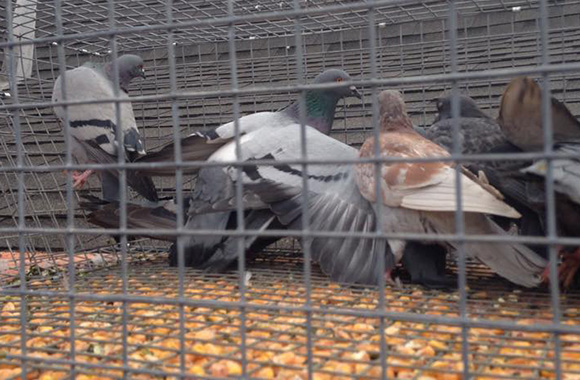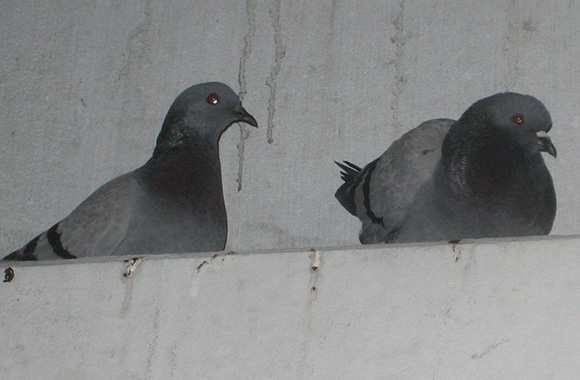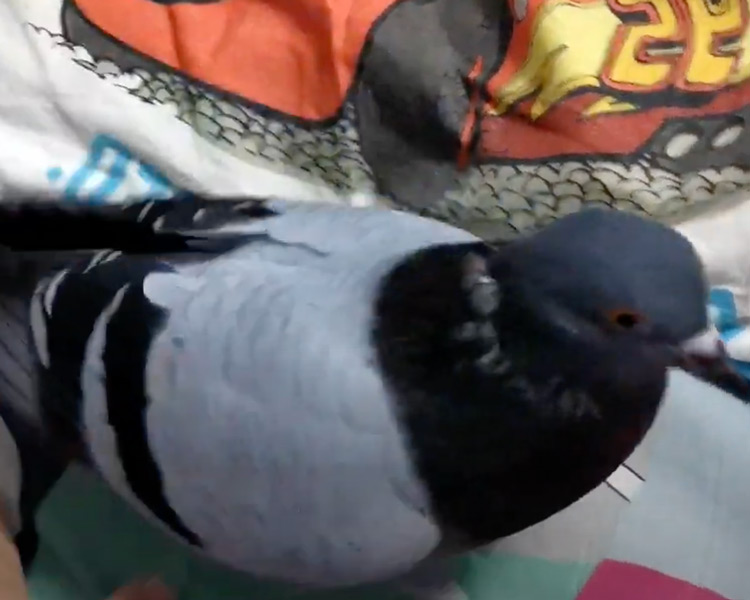Pigeon Control & Removal - How to Get Rid of Pigeons
The basic feral pigeon thrives throughout North America, and other countries Studies show that the pigeon is the highest ranked bird problem within areas populated by humans, particularly in urban areas. Pigeons can be found roosting around easy sources of food and water,
such as farms, grain bins, parks, bird feeders, skyscrapers, and most urban areas areas. They often nest on and in buildings, and various architectural features such as ledges, beams, and signage.
Pigeon droppings can be found in abundance anywhere pigeons frequent. Public seating, cars, or buildings are all likely targets for the unsightly, smelly and corrosive droppings. A Large concentration of droppings can kill plants, pollute bodies of water, and contaminate feed.
Pigeon guano can harbor histoplasmosis, a repertory disease that attacks the repertory system in the form of a fungus.
The parasites carried on pigeon’s bodies include mites, fleas, mites and ticks. In addition to being a serious health hazard, pigeons can threaten public safety as well, example; in airports, pigeon flocks have actually collided with moving aircraft, resulting in fatalities.


How to get rid of pigeons permanently - Pigeon control on buildings is fairly straigtforward, though often labor intensive. The principle is to eliminate their roosting and nesting areas. This is accomplished by installing physical barriers and deterrents that prevent the birds from
landing and roosting. On beams and ledges, popular products include bird spikes, slopes, and shock track. Spikes are, as the name implies, metal or plastic spikes installed on beams and ledges that prevent birds from landing. They are very common on buildings of all kinds. Shock track
also covers long, thin, areas, and is a wire with voltage that shocks the bird to discourage landing. Slopes prevent a flat surface to walk or nest on. To keep birds out of buildings, or other areas, such as support beams below a roof, netting is effective. In some cases, visual detterents
or larger scale deterrent devices are useful. Trapping is also an option to reduce or eliminate a specific population of pigeons in an area.
Read more about:
Bird Net Installation
Anti-Roosting Spikes
Shock Track Installation
Sound Harassment
Bird Trapping
Population Control
Visual Deterrents
FEEL FREE TO POST THE BELOW IMAGE ON YOUR WEBSITE: (just be sure to give me credit)

Click the above image for large version, or USE THIS CODE ON YOUR WEBSITE:
Control methods and Damage prevention - As with all nuisance wildlife, Elimination of sources of food, water, and living space are important factors in a long-term pigeon-control. A control program that involves use of repellents and toxins should only be used according to directions. . Please follow all product instructions. Using the “exclusion method” to restrict access to roosts, food sources, and water is a preferred means of pigeon-control. Block all openings to buildings especially lofts, vents, steeples, eaves, and any holes. It is suggested to repair damage with the proper materials, and refuse access to other areas through the use of mesh, or nylon netting. Screen the bottom side of rafters using net or a 1/4-inch mesh made from wire. This is effective in preventing roosting in sheds, barns, and other buildings.
Landscape netting or “overhead monofilament grid systems”, can keep pigeons from accessing small, outdoor areas like patios and desks. There are also commercial electric shock systems available to use in controlling birds. These will to run off a variety of birds, pigeons included. Electric deterrents are normally made of a plastic coated cable with electrical conductors. When the pigeon lands on the cable, and because of the attached conductors, the bird receives a shock that is designed to repel it but not kill it. Flashing lights, brightly colored cloth, and Mylar tape in smaller nesting areas can often work if used along with other techniques. Constant sprays of water have shown be effective when used to move pigeons from roosts. Water t must be sprayed in repeated intervals until you can be sure that the birds have relocated. Vitriol is a chemical known as a “frightening agent” used to repel problem birds, but it is also known to be lethal to birds if fed in higher amounts. .This is known as one of the most effective pesticides on the market today that is allowed for constant control of pigeons. Law requires that it must be administered by a licensed professional.
Nontoxic chemical repellents can also be found. They are available as pastes or liquid sprays. They are made to produce a sticky substance that makes it. Uncomfortable for pigeons when they try to land on treated sites. Traps can also be an effective control method. These can be purchased or DIY. They are usually 3 chambered and live trap the birds through the use of one way doors. The best location for traps is near pigeons’ major gathering areas. .Leaving a decoy bird or two in each trap at all times will lure in other pigeons. Please make sure the birds always have fresh food and water, and check your traps often. Pigeons are not protected because of their highly invasion and destructive nature.
Killing them is not against the law. Shooting pigeons with a .22-caliber rifle, 410-gauge shotgun or even a high-powered air rifle can rid you of a flock of pigeons in a short period of time. Check local laws before discharging any type of firearm in your area. Pigeons can also be hunted with bows, or high powered slingshots. If you can locate the nests, Destroying and the eggs at two-week intervals can greatly reduce pigeon population in just a few months. This method works best when used in conjunction with other control methods. Stopping their ability to reproduce is one of the most effective ways to cut down on pigeons in your area.
A bird contraceptive registered by the E P A is now available for controlling nuisance pigeons in the US. OvoControl P is an oral contraceptive served up to the birds in bait. It is designed to be used along with other prevention methods as an integrated approach for controlling pigeons. It has proved successful in trials at urban locations or other large areas where a reduced pigeon population is desired. OvoControl P stops eggs from hatching. It is nonlethal to the birds, and is administered on a daily basis in bait form. You can find more information and EPA studies by visiting the OvoControl website.

Pigeons are a nightmare when they’ve decided your home is now their home too. As well as being noisy, stealing food from your bird feeder, and even stealing food from your pets, they leave droppings around which spread disease, look very unsightly, and even corrodes the material it comes into contact with.
In order to get rid of them, you will need to observe the patterns of behaviour of your nuisance birds. Where do they land, roost or sit? If they always sit in a line across your roof, add spike strips to that section. You can also do the same with window sills, ledges, fence or wall tops, and similar. You will be taking away the ability to land there. In time, and with enough of their regular spots protected, the birds will move on.
Bird spike strips aren’t your only option when it comes to pigeons. You could look at netting, depending on the type of building you have and where you need to protect. This is usually an approach better suited to larger buildings, such as factories and warehouses, but is also used for council and city buildings.
If pigeons are entering your home, such as through the attic, you will need to find the entry points and then seal them up. If you don’t, the pigeons will continue to return. You must physically stop them.

